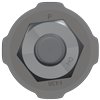Calibrated Wrench Bolting Method
The Calibrated Torque Wrench measure torque can never accomplish more than measuring the friction generated in the threads and on the nut face. This varies depending on many factors including, but not limited to lubricity of the threads and nut face, and thread tolerances and general thread condition. It is tension that determines the clamp loaded strength of a connection, NOT torque. Most research into torque, under the best conditions of bolt thread tolerances and lubrication is bolt tensions varying by plus or minus 30% at a given torque. Our new DVD includes an excellent documentary on why torque generally fails to accomplish a given measurement of fastener tension. It describes that the “K factor” which is the friction factor is a moving target and cannot be controlled. On construction sites deteriorating conditions are so exacerbated as to render torque measurement pretty well useless.
A recent study, comparing torque installation following EU standard EN 1090-2 (view report) for torque tightening bolts with DTIs, most bolts tightened by torque measurement were under tensioned, some by a wide margin. RCSC (USA) code correctly requires so many checks on torque tools and fasteners as to render torque measurement almost impractical. Torque measurement was once completely banned in the RCSC specification in the early 1980s. In TurnaSure’s view, that decision was correct.
Contact TurnaSure today for more information, availability and quotes.

 Contact Us
Contact Us